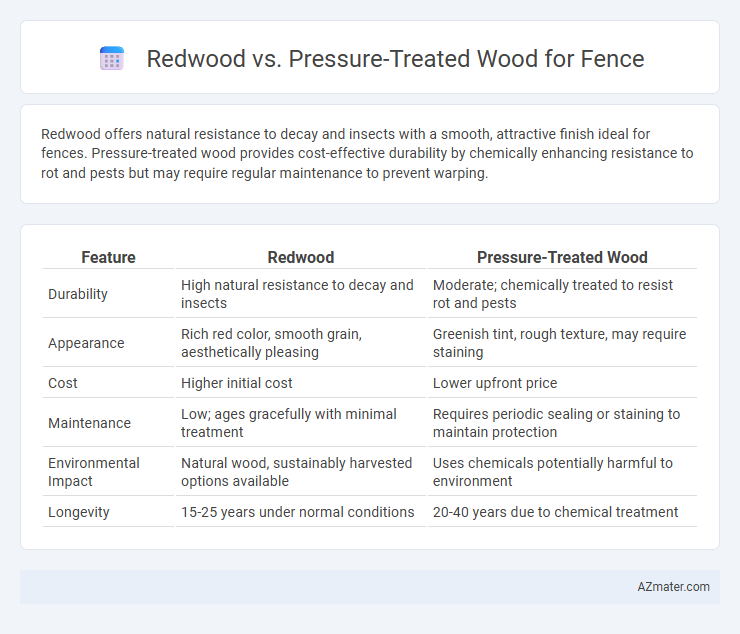Redwood offers natural resistance to decay and insects with a smooth, attractive finish ideal for fences. Pressure-treated wood provides cost-effective durability by chemically enhancing resistance to rot and pests but may require regular maintenance to prevent warping.
Table of Comparison
| Feature | Redwood | Pressure-Treated Wood |
|---|---|---|
| Durability | High natural resistance to decay and insects | Moderate; chemically treated to resist rot and pests |
| Appearance | Rich red color, smooth grain, aesthetically pleasing | Greenish tint, rough texture, may require staining |
| Cost | Higher initial cost | Lower upfront price |
| Maintenance | Low; ages gracefully with minimal treatment | Requires periodic sealing or staining to maintain protection |
| Environmental Impact | Natural wood, sustainably harvested options available | Uses chemicals potentially harmful to environment |
| Longevity | 15-25 years under normal conditions | 20-40 years due to chemical treatment |
Introduction to Redwood and Pressure-Treated Wood
Redwood, known for its natural resistance to decay and insect damage, offers a durable and aesthetically pleasing option for fencing with rich color and fine grain. Pressure-treated wood undergoes a chemical infusion process that enhances its resistance to rot, fungi, and insects, making it a cost-effective and widely available material for outdoor use. Both materials provide longevity for fences but differ significantly in maintenance, environmental impact, and visual appeal.
Durability Comparison: Redwood vs Pressure-Treated Wood
Redwood offers natural resistance to rot, insects, and decay due to its dense grain and natural oils, making it highly durable for fence applications without chemical treatments. Pressure-treated wood undergoes a chemical infusion process that protects against moisture, fungi, and insect damage, extending its lifespan but potentially risking warping or splintering over time. In terms of longevity, redwood typically lasts 15-25 years with proper maintenance, while pressure-treated wood can endure 20-30 years depending on environmental conditions and care.
Cost Analysis: Which is More Affordable?
Pressure-treated wood typically costs between $1 to $3 per linear foot, making it the more affordable option for fence construction compared to redwood, which ranges from $5 to $9 per linear foot. The initial lower price of pressure-treated wood is offset by its shorter lifespan of 15-20 years, while redwood can last 25-30 years due to its natural resistance to decay, potentially reducing replacement frequency and long-term costs. Maintenance expenses also vary; pressure-treated wood requires regular sealing to prolong durability, whereas redwood's natural oils reduce maintenance needs, influencing the overall cost-effectiveness analysis.
Appearance and Aesthetic Appeal
Redwood offers a rich, natural reddish-brown color that enhances fence aesthetics with its fine grain and smooth texture, providing a visually appealing, upscale look. Pressure-treated wood typically has a greenish hue due to chemical treatment, which can be less attractive but may be painted or stained to improve appearance. Over time, redwood naturally weathers to an attractive silvery-gray, maintaining its aesthetic appeal without requiring frequent maintenance, unlike pressure-treated wood that may suffer from warping or splintering.
Maintenance Requirements for Each Material
Redwood fences require minimal maintenance due to their natural resistance to rot, decay, and insects, often needing only occasional cleaning and sealing every 2-3 years to maintain their appearance. Pressure-treated wood demands more frequent upkeep, including annual inspections for splinters or cracks, cleaning, and application of water-repellent sealant or stain every 1-2 years to protect against moisture and prevent warping. Both materials benefit from proper installation and drainage to extend fence longevity and reduce maintenance needs.
Environmental Impact: Sustainability and Eco-Friendliness
Redwood offers a more sustainable option for fencing due to its natural resistance to decay, requiring less chemical treatment and longer lifespan, which reduces environmental waste. Pressure-treated wood, while widely available and cost-effective, involves the use of chemical preservatives like copper azole or alkaline copper quaternary that can leach into soil and water, impacting local ecosystems. Choosing sustainably harvested redwood certified by organizations such as FSC supports responsible forestry practices and helps minimize ecological footprints compared to chemically treated alternatives.
Resistance to Insects and Rot
Redwood offers superior natural resistance to insects and rot due to its high tannin content, making it a durable choice for fencing in humid or pest-prone areas. Pressure-treated wood is chemically infused with preservatives that protect against insect damage and fungal decay, providing long-lasting performance in various environments. While redwood is often preferred for its aesthetic appeal and environmental sustainability, pressure-treated wood can be more cost-effective and widely available with similar protective benefits.
Ease of Installation and Workability
Redwood offers superior ease of installation thanks to its lightweight and natural resistance to splitting, making it easier to cut, nail, and shape compared to pressure-treated wood. Pressure-treated wood, while durable, tends to be heavier and denser, often requiring pre-drilling to prevent splitting, which can slow down the installation process. Workability favors redwood as it maintains stability and smoothness during woodworking, reducing effort and tool wear on fencing projects.
Lifespan and Long-Term Value
Redwood fences offer a lifespan of 20 to 30 years due to their natural resistance to decay, insects, and weathering, making them a durable investment for long-term use. Pressure-treated wood typically lasts 15 to 20 years, as chemical treatments protect it from rot and pests but may require more frequent maintenance over time. When considering long-term value, redwood's aesthetic appeal and lower maintenance needs often justify its higher upfront cost compared to the more affordable but shorter-lived pressure-treated option.
Conclusion: Choosing the Best Wood for Your Fence
Redwood offers natural resistance to decay and a rich, attractive appearance, making it ideal for aesthetic-focused fencing projects with a higher budget. Pressure-treated wood provides superior affordability and durability through chemical treatment, ensuring longevity even in harsh weather conditions. Selecting between the two depends on prioritizing either visual appeal and natural durability or cost-effectiveness and enhanced resistance to insects and rot.

Infographic: Redwood vs Pressure-treated Wood for Fence
 azmater.com
azmater.com